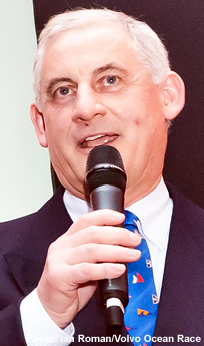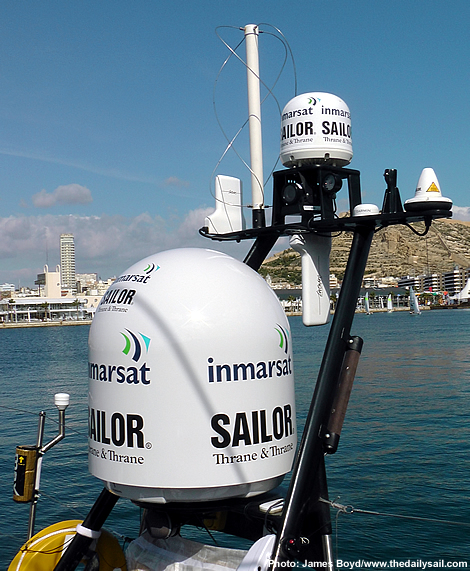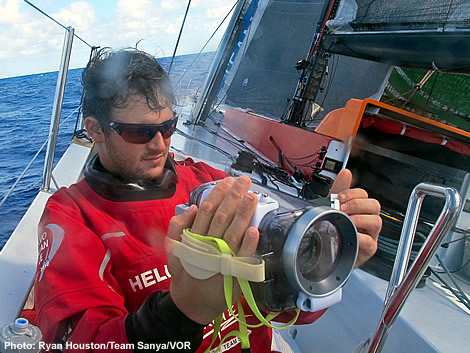TV revolution in offshore racing
The media show component of round the world and oceanic racing is to undergo a revolution in the not-so-distant future.
Already the Volvo Ocean Race media crewmen are beaming high definition video back from on board, regardless of where their boats are in the world and in what conditions. Other events such as the Barcelona World Race have pioneered the use of video conferencing, with skippers able to be interviewed live from the high seas.
At present the Volvo Open 70s carry a plethora of satellite equipment. This includes the belt and braces Inmarsat C, the backbone of the satcoms gear on race boats since it was introduced in 1991. Since 1 February 1999 this data-based gear is also part of the International Maritime Organisation specification for GMDSS (Global Maritime Distress and Safety System). On race boats it is used principally for automatic position reporting (when the C terminal is hooked up to a GPS) and for alerting the rescue authorities in the event of a distress situation.
 In the past Inmarsat C has been used for sending and receiving telexes and as recently as the 2008-9 Volvo Ocean Race when, as the boats leaving Qingdao, it was used by the then Ericsson 4 navigator Jules Salter as a means of downloading a weatherfax, necessary during a 10 day outage of the regular satcom services, due to Inmarsat shuffling their satellites around. “He succeeded, but I don’t think any of the other crews knew how to tap into that technology,” recalls Chris McLaughlin, Inmarsat’s Vice President of External Affairs, and himself a regular in Ian Southworth’s J/24 crew. “So it was quite a smart move by the eventual race winners.”
In the past Inmarsat C has been used for sending and receiving telexes and as recently as the 2008-9 Volvo Ocean Race when, as the boats leaving Qingdao, it was used by the then Ericsson 4 navigator Jules Salter as a means of downloading a weatherfax, necessary during a 10 day outage of the regular satcom services, due to Inmarsat shuffling their satellites around. “He succeeded, but I don’t think any of the other crews knew how to tap into that technology,” recalls Chris McLaughlin, Inmarsat’s Vice President of External Affairs, and himself a regular in Ian Southworth’s J/24 crew. “So it was quite a smart move by the eventual race winners.”
In addition to Inmarsat C, the boats are equipped with a FleetBroadband 500 unit supplied by Danish manufacturer Sailor/Thrane & Thrane. This is the workhorse unit, capable of operating at 432kbps, via the larger 600mm diameter dome mounted on the antenna rack above the transom on each VO70. The 500 is used to beam back high definition video from on board, and also handles less data-intense work such as transmission of still images, downloading the weather data regularly sent to the crews by the race organisers, along with voice comms, email and texting.
The 500 is backed up by a FleetBroadband 150 unit, with a smaller 275mm diameter antenna and a 150kbps data rate.

“The FleetBroadbands have for the first time a safety service – ‘555’. They have a guarded red button that you see on the communications desk below deck," says McLaughlin. "So if you press the button, it will put a call through for you and route it to the nearest coastguard service to where you are and that is an additional service to what you have with Inmarsat C.” It should be noted that the distress message emanating from this equipment gets through to the rescue services substantially faster than it does via the ancient COSPAS-SARSAT system from an EPIRB – which is significant if you consider an incident like the Rambler 100 capsize. The VO70s also have a MOB button (that sends a digital Mayday via Inmarsat) located in the back of the cockpit.
In a first for this race, each VO70 is also equipped with an IsatPhone Pro, a more GSM phone-like device used principally for voice communications, although it can also send and receive email and text messages.
Revolution
In subsequent races on board satcoms gear is set to be upgraded dramatic as Inmarsat introduces its latest technology. In 2013, Inmarsat’s satcom offering will be transformed with the launch of three new Inmarsat 5 (I5) satellites. The I5 satellites are to be built by Boeing and are expected to be launched and ready for service by the end of 2014 (ie just in time for the next Volvo Ocean Race). The new service to harness the power of the Inmarsat 5 satellites will be called Global Xpress and will be able to operate at 50 MB/second, ie around the speed that fibre optic-based domestic broadband is claimed to operate at currently and more than 10 times faster than the maximum data rate available from the most powerful FleetBroadband transceivers currently.
Aside from the inevitable improvements in technology as time passes (aka Moore’s Law: the number of transistors that can be placed on a chip doubles every two years), the increased data rate is possible as the new I5 satellites operate at a higher frequency – in what is known as the ‘Ka’ band (ie 26.5-40GHz) whereas the present FleetBroadband units work in the ‘L’ band (1-2GHz). According to Chris McLaughlin the L-Band was originally allocated to the Inmarsat services 31 years ago as this frequency band had been proved to show the least degradation due to atmospheric and meteorological effects.

So how will the new technology affect the Volvo Ocean Race? Assuming that the organisers once again choose to go with Inmarsat as their satcoms provider, then Chris McLaughlin says that Global Xpress will allow broadcast quality video to be transmitted back from the boats live. “It will be a transformation technology, not least for yacht racing because you’ll be able to see in real time what is going on on board the boats, without the need for editing a package and then compressing it and sending it off the boat.” So the ability to stream live HD video from on board or carry out a live interview will be a real possibility and could lead, if the organisers are brave enough, to the Volvo Ocean Race becoming a reality show-type TV product, where at any time of day or night members of the public can actually see what is going on on board any of the boats.
“It is going to transform things and it is going to get interesting, because the crew will be under constant scrutiny," says McLaughlin. "The MCM will have to be a cross between a killer instinct Big Brother filmer and a UN diplomat and they will require a very developed set of skills to enable them not to be thrown overboard along with their camera at the earliest opportunity! The professional sailors will have torecognise that they are now part of a scrutinised fraternity - just like a footballer or rugby player or anyone else.”
While this technology will be available, the limiting factor (aside from cost) is likely to be whether the boats can generate enough power to drive the new Global Xpress terminal for prolonged periods.
Obviously this coming to fruition for the next Volvo Ocean Race depends upon roll-out of the I5 satellites continuing on schedule. “With rockets it is always binary – it either blows up or it works! But we haven’t - touch wood - lost one from the last 11 satellites launched,” says McClaughlin.
So next time around the VO70s might be equipped with one of the present smaller FleetBroadband units as a back-up and a Global Xpress terminal. This will feature a 600mm diameter dome of a similar size to the existing FleetBroadband 500 units.
In terms of $$$$, costs are still on the steep side with the retail price for data transmission being around US$5-6 per MB currently. However of interest is that calls are typically just US$1 per minute, which in many cases is cheaper than the international roaming charges for GSM. So an IsatPhone Pro is genuinely worth considering for the international traveller. “It looks like a Motorola phone from the 1980s - a brick,” says McClaughlin. “It is designed to be a US$500 piece of kit and highly resilient. It works in extremes of heat and cold or with a gloved hand. It is a functional, rugged, professional phone rather than trying to make a satellite phone work like a GSM phone. You might have noticed them in Libya – many of the rebel forces were using them...”
The Inmarsat 5 satellites are principally being launched to fulfil the needs of the US Department of Defence but will also be of considerable use to other markets such as broadcasters and the maritime and aviation markets and the rescue services, etc.
“About 55-60% of our business is maritime now,” says McLaughlin. “When I joined seven years ago, it was about 61-62%. Our biggest single customer is the US DoD, but maritime is a key part of our business, because ships over 300 tonnes have a must-carry rule for the Inmarsat safety services. So they install the Fleet or Fleet Broadband and the Inmarsat C and logically they tend to carry on with the next generation equipment.”
As with their Inmarsat 3 and Inmarsat 4 satellites, their new generation birds will be what are termed ‘geostationary’, so they will maintain an orbit at 22370 miles over fixed points around the equator to provide global coverage with the exception of the poles. This is a fundamental difference between Inmarsat’s satcom system and those of other providers, such as Iridium which uses a constellation of low earth orbiting (LEO) satellites – in Iridium’s case 66 LEO satellite circling the planet at an altitude of just 485 miles.
Prior to the launch of the I5 satellites, Inmarsat plans in 2013 to launch an intermediate satellite called AlphaSat - known in house as ‘Inmarsat XL’ or ‘Inmarsat 4.5’. “That will have double the data processing capability of the I4s, which will make them even more data efficient,” says McLaughlin. Another L-band satellite, Inmarsat XL's beam will be over Africa, so its footprint will include Europe, the Middle East and Africa. This satellite will service some of the areas where there is currently most demand on the Inmarsat system. “You can imagine North Africa, Iraq, Afghanistan, etc have put quite a lot of strain on the L-Band infrastructure for communications and government services. So AlphaSat will assist that and will put effectively a fourth I4 into space giving us complete redundancy of the service,” says McLaughlin.
In due course the Inmarsat 3 satellites, now 13-15 years old, will be taken out of service. “If you think that a year in space is roughly the equivalent to 7-8 years of normal wear and tear, with the extremes of heat and cold and the radiation bombardments they get - they are very good satellites, but pretty old. So it is time to step up.”
Old satellites get dispatched to a satellite graveyard in space. “By international agreement we are required to keep just enough fuel to push the satellites up to the satellite grave yard, which is a space between the Earth and the sun where, because of gravitational pull, they are effectively frozen forever.”










Latest Comments
James Boyd 05/03/2012 - 12:16
Probably not well... the point was rather than taking around 2 hours for the rescue authorities to leap into action, that that all-important time period could have been reduced.940197 29/02/2012 - 20:04
Quote "It should be noted that the distress message emanating from this equipment gets through to the rescue services substantially faster than it does via the ancient COSPAS-SARSAT system from an EPIRB – which is significant if you consider an incident like the Rambler 100 capsize." How well does it work when it is underwater and pointing in the wrong direction?Add a comment - Members log in